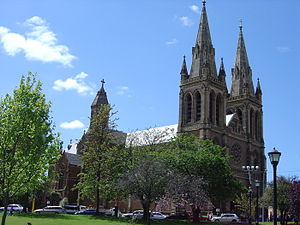St Peter's Cathedral, Adelaide
| St Peter's Cathedral | |
|---|---|
| Cathedral Church of St Peter | |
 |
|
| 34°54′46″S 138°35′53″E / 34.91278°S 138.59806°ECoordinates: 34°54′46″S 138°35′53″E / 34.91278°S 138.59806°E | |
| Location | Adelaide, South Australia |
| Country | Australia |
| Denomination | Anglican |
| Website | stpeters-cathedral |
| History | |
| Founded | 1869 |
| Dedication | St Peter the Apostle |
| Architecture | |
| Functional status | Active |
| Heritage designation | Historic |
| Designated | 1980 |
| Architect(s) | William Butterfield & Edward John Woods |
| Style | Gothic Revival |
| Specifications | |
| Bells | 8 |
| Tenor bell weight | 41cwt (2.09 tonnes) |
| Administration | |
| Diocese | Adelaide |
| Province | South Australia |
| Clergy | |
| Archbishop | Jeffrey Driver |
| Bishop(s) | Tim Harris |
| Dean | Frank Nelson |
| Precentor | Jenny Wilson |
St Peter's Cathedral is an Anglican cathedral in the South Australian capital of Adelaide. It is the seat of the Archbishop of Adelaide and Metropolitan of the Province of South Australia. The cathedral, a significant Adelaide landmark, is situated on approximately one acre (4,000 m2) of land at the corner of Pennington Terrace and King William Road in the suburb of North Adelaide.
The south front has similar features to the Cathedral of Notre Dame and the Church of St Jean-Baptiste de Belleville in Paris, including an ornate rose window above the main entrance which depicts stories of South Australia and the Bible.
The See of Adelaide was constituted in June 1847. As there was no cathedral, Trinity Church on North Terrace was denoted as the pro tempore cathedral church. Augustus Short, the first Bishop of Adelaide, held the first ordinations there on 29 June 1848 (St Peter's feast day). When Adelaide was surveyed by Colonel William Light over a decade before, land in Victoria Square had been set aside for public use. Bishop Short obtained a land grant in the square from Governor Robe in March 1848; the grant was registered on 23 April 1851. By late 1849 a subscription was bringing in funds for construction of a cathedral on the now cleared site. Around this time the legality of the land grant began to be publicly questioned. It was argued that the area was a public reserve and the governor had no power to issue such grants. To resolve matters Bishop Short, supported by the Synod, took the matter to the Supreme Court. The judgment in June 1855 confirmed that the grant was invalid and construction could not proceed.
...
Wikipedia
